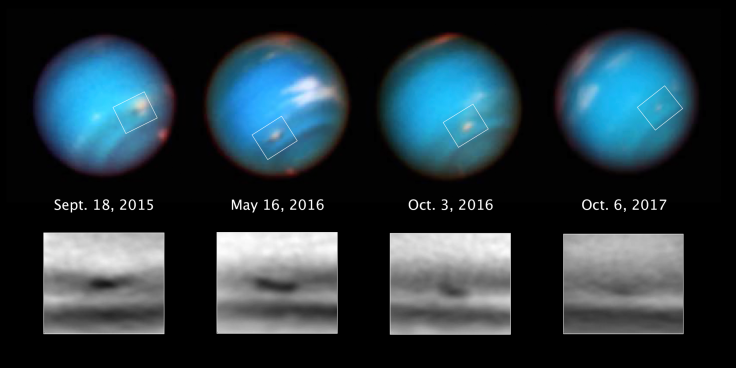NASA’s Hubble Space Telescope Watches Dark Neptune Storm Shrink

NASA scientists are watching a storm die on Neptune as the Hubble Space Telescope broadcasts this kind of event for the first time.
The storm on the solar system’s farthest planet started as wide as the Atlantic Ocean but that dark spot is getting smaller and smaller, right before Hubble’s mechanical eyes, NASA said. Although storms have come and gone in the decades since NASA’s Voyager 2 spacecraft whizzed by closer than any man-made object had approached Neptune, the space agency reported that this is the first time it is actually seeing a storm diminish into oblivion.
“Like Jupiter’s Great Red Spot, the storm swirls in an anticyclonic direction and is dredging up material from deep inside the ice giant planet’s atmosphere,” according to NASA.
And it probably stinks: “The dark spot material may be hydrogen sulfide, with the pungent smell of rotten eggs.”
A study in the Astronomical Journal notes that beyond the novelty of watching it die, observing the storm as it fades away will offer clues about how Neptune’s weather system works, including its winds.
Astronomers do not currently know much about how storms form, how quickly they move or what is going on within them.

“Many questions remain as to how dark vortices originate, what controls their drift and oscillation, how they interact with the environment, and how they eventually dissipate,” according to the paper. “Vortex behavior also provides insight into the structure and dynamics of the surrounding atmosphere.”
So far, what the scientists are observing is not what they expected. They had predicted that the anticyclone would move toward Neptune’s equator and then break apart dramatically, which would “perhaps create a spectacular outburst of cloud activity,” researcher Michael H. Wong said in the NASA statement.
The slow fade Hubble is capturing goes against that model, and shows the storm moving more south as opposed to north in the direction of the equator.
“Unlike Jupiter’s [Great Red Spot], the Neptune spot is not as tightly constrained by numerous alternating wind jets (seen as bands in Jupiter’s atmosphere),” the space agency said. “Neptune seems to only have three broad jets: a westward one at the equator, and eastward ones around the north and south poles. The vortex should be free to change traffic lanes and cruise anywhere in between the jets.”
© Copyright IBTimes 2025. All rights reserved.



















